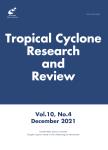ROLE OF SEA SURFACE TEMPERATURE IN MODULATING LIFE CYCLE OF TROPICAL CYCLONES OVER BAY OF BENGAL
ROLE OF SEA SURFACE TEMPERATURE IN MODULATING LIFE CYCLE OF TROPICAL CYCLONES OVER BAY OF BENGAL作者机构:School of Earth Ocean and Climate SciencesIndian Institute of Technology BhubaneswarOdishaIndia Department of Earth and Atmospheric SciencesNational Institute of Technology RourkelaOdishaIndia National Center for Medium Range Weather ForecastingNoidaUttar PradeshIndia
出 版 物:《Tropical Cyclone Research and Review》 (热带气旋研究与评论(英文版))
年 卷 期:2019年第8卷第2期
页 面:74-89页
学科分类:07[理学] 070601[理学-气象学] 0707[理学-海洋科学] 0706[理学-大气科学]
基 金:Indian National Center for Ocean Information Services (INCOIS) Indo-US Science and Technology Forum New Delhi DST-INSPIRE for providing financial support to carry out the research work
主 题:tropical cyclone HWRF SST Bay of Bengal
摘 要:Sea surface temperature(SST) varies significantly in the presence of tropical cyclones(TCs). Using fixed SST throughout the integration of high resolution TC models is general practice in research and operational endeavor over the North Indian Ocean. The present study is to assess the impact of updating realistic SST in TC lifetime on track, intensity and rainfall of TCs. The Hurricane Weather Research Forecast(HWRF) model of single domain with 9 km resolution is used. A total of 31 forecast cases are considered from 6 TCs during 2007-16 with unique track and intensity characteristics. A set of two numerical experiments are done without(CNTL) and with 6-hourly SST update(SST) in TC *** track and intensity errors show that there is an improvement of 3–41% in track during 12–120 h forecast length for SST run. The SST runs improve landfall position and time prediction by 20% and 33% respectively. The cross track error of SST run is comparable(44 km) with average errors available for this basin(34 km);and along track errors are improved by 60% as compared to CNTL as well as average errors of the basin. The model is biased to overestimate a weaker TC and underestimate a stronger TC, however, the bias is reduced in SST run by 5–51%. The analyses of wind, enthalpy flux and warm core structures provide insight for realistic intensity prediction of SST run unlike CNTL. Rainfall intensity and radial distribution is also improved in SST run. Thus, this study highlights the significance of ocean coupling with TC models to advance forecast guidance.



